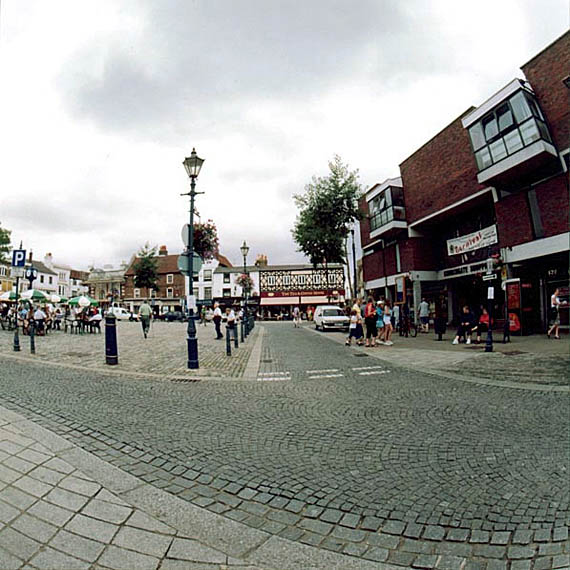 C297-6: 30mm Zodiak at f/11: scan from lab print |
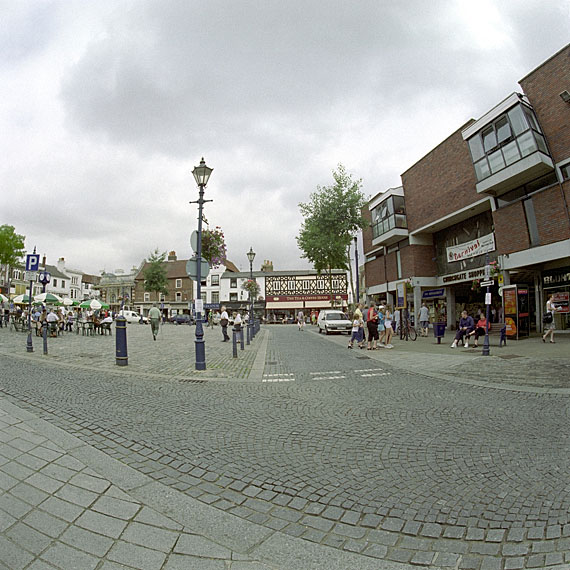 C297-6n: 30mm Zodiak at f/11: scan from negative |
Performance
I don’t have a Carl Zeiss 30mm Hasselblad lens, and have no plans to buy one, not even second-hand, but side-by-side tests have been carried out by others, and they show the following:
 C297-6: 30mm Zodiak at f/11: scan from lab print |
 C297-6n: 30mm Zodiak at f/11: scan from negative |
There is no vignetting (light fall-off) with the fish-eye lenses
from either of these manufacturers; coverage is superb right into
the corners.
Using the lens
Why use a fish-eye lens? These lenses can create special
effects, but in most cases people use them simply to get a
wider angle of view; to get more into the picture.
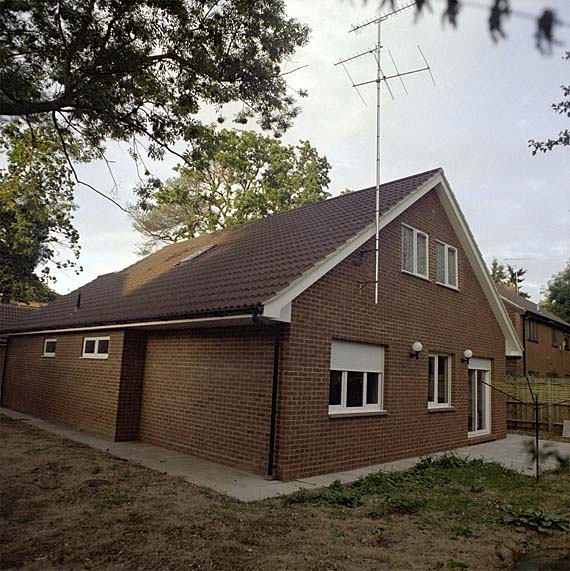 C184-9: 45mm Mir 26B on Exakta 66: 1/60 at f/5.6 This lens has a diagonal angle of view of 83 degrees, compared with the 180° of the Zodiak/Arsat 30mm lens. |
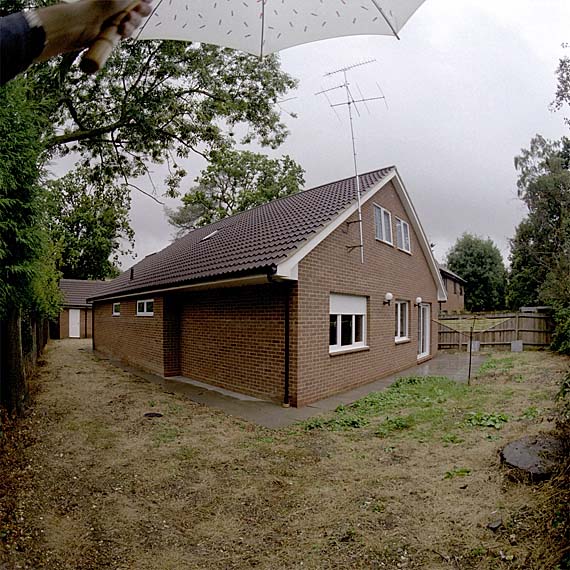 C184-10: 30mm Zodiak on Exakta 66: 1/60 at f/6.3 Here it was raining, and the image shows how hard it is to shield the camera with an umbrella without seeing the umbrella in the frame, when using a fish-eye lens! |
Using a fish-eye lens requires careful thought and suitable composition. Most of the time, people prefer distortion-free images, and the following two features affecting images produced with fish-eye lenses should be borne in mind:
 C184-10: Straight lines going through the centre of the image remain straight. 30mm Zodiak lens on Exakta 66, 1/60 at f/6.3 However, it does look as though the aerial mast is bending, which was not the case. |
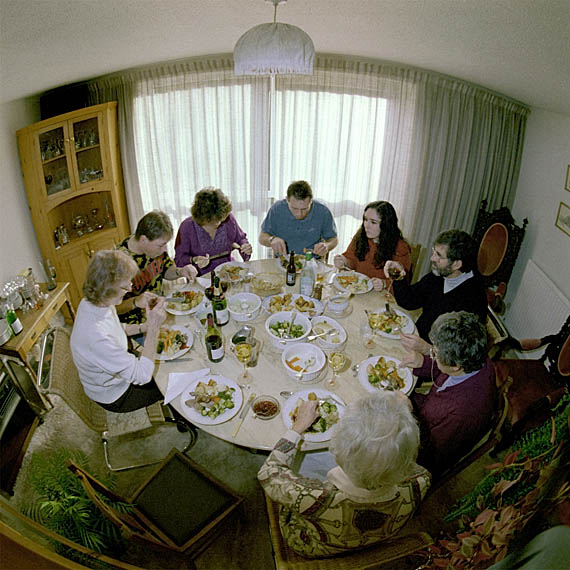 C230-1: Circles whose centre is near the centre of the image remain circles. 30mm Zodiak on Pentacon Six: direct flash at f/5.6 However, the curtain rail near the top of the image was certainly straight! |
Undoubtedly, the best images will not have straight lines near
the edges of the frame. If the meal at the round table had
been eaten at a picnic spot, it is possible that curvature of a
grass background would have passed unobserved.
(This image has also been chosen because it does not show
the faces of most of the people at the meal. If they had all
been smiling at the camera, it might have been a better
image, and the viewer’s attention might not have drifted away to
the curtain rail.)
Post-processing
It may be that the best solution is to combine the unsurpassed quality of image capture on film with the power of the computer to reduce the fish-eye effect. To do this, the best solution is to scan in the film image, and not to work from a scan of a print, since the lab may have lost image detail (especially highlights and shadow detail) when printing.
Many image-manipulation programs include a feature to reduce barrel distortion (which is what one gets with a fish-eye lens), although in some cases it may struggle to cope with fish-eye images. There are also various free “plug-ins” available on the internet.
If there is anything worse than having straight lines near the
edge of fish-eye images, it is having people near the edge
of such images, as we are a lot less tolerant to seeing people
distorted. However, sometimes a fish-eye lens is the only
way to get a wide enough angle of view, and in these cases,
de-barrelling software may help. Here is an image, before
and after being modified by such a program.
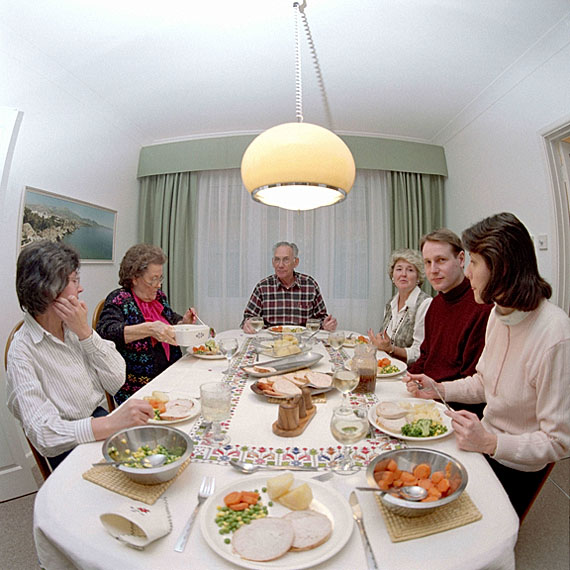 C202-14 Zodiak -8B on Pentacon Six Bounce flash f/4.5 Notice the thin, curved body and face of the person on the extreme right, the doors that curve in on either side, and the curved curtain pelmet. Distortion of the person on the extreme left is less obvious, as she is slighty further away from the edge of the frame. |
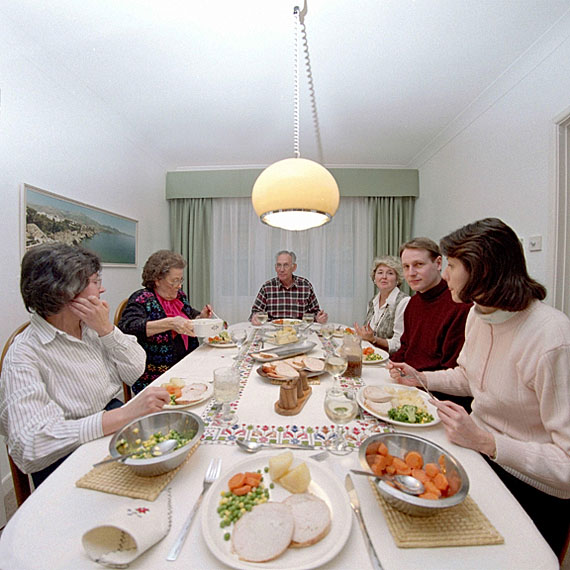 C202-14 with lens corrector processing Three applications of this particular plug-in were needed to reach this degree of correction. The image is different. Neither image is free from distortion, but in this image there is less distortion of the face of the person on the right and of the curtain pelmet. However, the two circular serving dishes near the bottom corners have become stretched, and I cropped off the right-hand elbow, which was being pulled out to a point. With even more effort, the original images of the dishes could be placed here, although the processing time required to finish the picture is now becoming significant. |
We can have a go at using lens corrector software with the town square image at the top, to see the effect.
 C297-6n: 30mm Zodiak at f/11: scan from negative No distortion correction applied. |
 C297-6n with lens corrector processing I applied this plug-in once, but then used Transform, part of the main program, to restore the perspective as much as possible. The shape of the kerbstones in the foreground has changed substantially, but this is not unacceptable. |
Using lens corrector software is a nuisance, but in my experience is much easier and faster than the alternative: shooting several images and then subsequently stitching them together on the computer. Corrected fish-eye images also deliver better results than stitched images, at least of interiors of buildings, in my experience.
All fish-eye images shown above were shot using the Zodiak-8 single-coated lens. The results definitely look more than satisfactory.
If you want to get one of the MC Arsat multi-coated lenses, I suggest that you contact the eBay trader “grizzly33bear”, from whom I bought mine. I believe that she may still have some new examples of this remarkable lens. If not, I suggest that you set up a search on eBay. They do appear from time to time.
| Further examples of the 30mm lens in use In this case, we are using the newer Arsat MC version of the lens. The Hanbury Hill Chapel has stood in Stourbridge, England, since 1836. In the 21st century it is still used by an active community of Christians in the town, and is now known as Hope Baptist Church Stourbridge. (See here: https://hopebaptistchurchstourbridge.org.uk/ for more information. Accessed on 10.1.22.) As well as the main, downstairs, area, which provides seating for most attendees, there is also a first-floor balcony along the back and both sides of the main sanctuary. The building is not very long from front to back, so to include the full interior width for a Pentacon Six photograph it was necessary to use the 30mm fish-eye lens. As the building is not round, it was desirable to remove the distortion that is always caused by fish-eye lenses. On the left, below, we show the original image, and on the right the result of digital processing to minimise distortion. |
||
 Image as shot With this hand-held image, the camera is slightly crooked. We also observe slight vignetting in the top corners. (It is also no doubt present in the bottom corners, but as that part of the image is darker, it is not noticed.) [C548_14-15af_orig_s.jpg] |
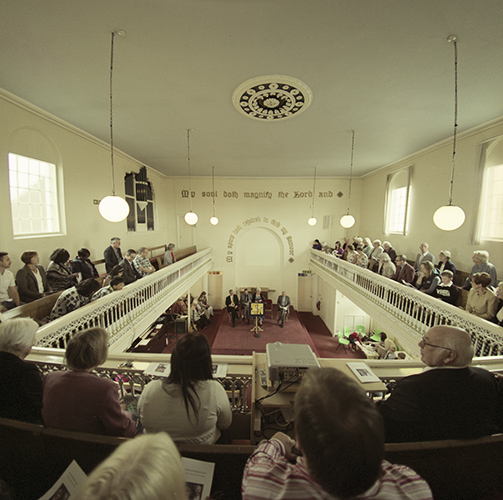 Image processed in Affinity Photo “Photo Persona” (Filters/Distort/Lens Distortion) The image has also been straightened and trimmed. Stretching out the corners of the image has removed the vignetting from the part of the frame that is still visible. [C548_14-15af_corr_s.jpg] |
|
| Pentacon Six Fuji
PRO400H 24/9/16 Induction of Dave Morris as minister of
Hanbury Hill Baptist Church, Stourbridge 30mm Arsat at
f/3.5, hyperfocal, 1/30 sec hand-held In the corrected image, the rail at the front of the balcony, and the back of the row of seats, is not totally straight, but most distortion has been reduced substantially. We also note that the cables that hold the two hanging lights nearest to the edges of the image are not totally straight, nor are the windows. Further correction could deal with this. However the image as currently corrected is probably acceptable. We can see that, even at maximum aperture, the resolution of this lens is excellent. If it had been possible to stop down the aperture, the resolution and the depth of field would have been better. Clicking on either image opens a larger copy. |
||
Back to “The Scene Chosen for the tests”
To go on to the next section, click below.
Next section: What is the widest rectilinear
lens available for the Pentacon Six?
To go back to the beginning of the lens tests, click below and
then choose the focal length that you want to read about.
Back to beginning of lens tests
© TRA August 2008 Latest revision: January 2022